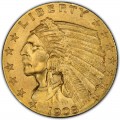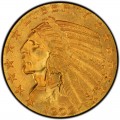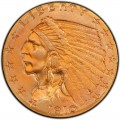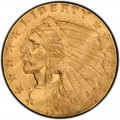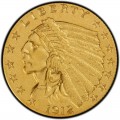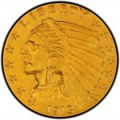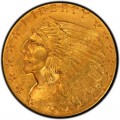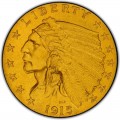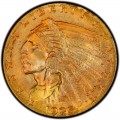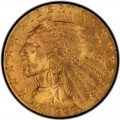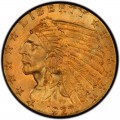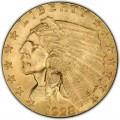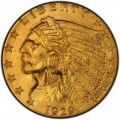- United States Coins
- Indian Head Quarter Eagles
Indian Head Quarter Eagles
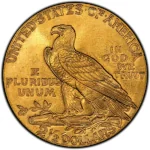 Indian Head $2.50 quarter eagle gold coins have the unique distinction of being just one of two U.S. coins to feature an incuse design. That means the devices, date, and lettering on the coin goes into the surface rather than standing proud of the surface, as is common with relief coins. Indian Head quarter eagle gold coins were originally much disliked by the public as fears arose that the incuse design would harbor bacteria and spread disease. Those concerns have been long disproven and the Indian Head $2.50 coin today has become a well-loved classic U.S. gold coin.
Indian Head $2.50 quarter eagle gold coins have the unique distinction of being just one of two U.S. coins to feature an incuse design. That means the devices, date, and lettering on the coin goes into the surface rather than standing proud of the surface, as is common with relief coins. Indian Head quarter eagle gold coins were originally much disliked by the public as fears arose that the incuse design would harbor bacteria and spread disease. Those concerns have been long disproven and the Indian Head $2.50 coin today has become a well-loved classic U.S. gold coin.
All Indian Head Quarter Eagles except the 1911-D can be had for about $705 in lower circulated grades, while uncirculated specimens start at around $805 and go up to roughly $5,500 or more for most high-grade mint states, with certain years getting even more pricey.
Identical in design to the Indian Head $5 half eagle gold coin (which is the other U.S. coin featuring an incuse design) of the same 1908 to 1929 run, the Indian Head quarter eagle was designed by Bela Lyon Pratt, a pupil of the famous sculptor Augustus Saint-Gaudens. Saint-Gaudens famously designed the Indian Head $10 eagle gold coin and namesake $20 double eagle gold coin.
Indian Head $2.50 quarter eagles weigh 4.18 grams and contain 0.12094 ounces of gold. While they are often purchased by gold bullion investors, Indian Head quarter eagles are much more widely collected by numismatists and are valued as a scarce collector coin. While all Indian Head quarter eagle gold coins are rare, the scarcest of all, by date, is the 1911-D quarter eagle, which has a mintage of just 55,680 pieces and a much smaller surviving population today, commanding a price of about $2,600 for a Extremely Fine 40 specimen. As few Indian Head quarter eagle gold coins were saved by collectors early on, there are relatively few pieces surviving today in the higher grades.
Below is a list of Indian Head Quarter Eagle info sheets for each year of issue. Each info sheet includes detailed pricing and mintage numbers for each variant.
-
{{#owner}}
-
{{#url}}
{{#avatarSrc}}
{{name}} {{/url}} {{^url}} {{#avatar}} {{& avatar}} {{/avatar}} {{name}} {{/url}} - {{/owner}} {{#created}}
- {{created}} {{/created}}

